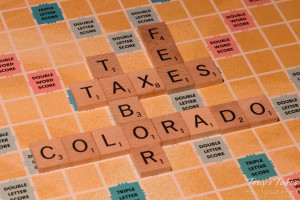Sharf: Ending Taxpayer’s Bill of Rights refunds a deservedly tough sell to voters
Another year, another legislative attempt to erode Colorado’s Taxpayer’s Bill of Rights (TABOR).
TABOR opponents, bored with chipping away at the law’s foundations, have broken out the chainsaws. On the one hand, legislative Democrats are ignoring the plain language of TABOR and unilaterally enacting a universal income tax increase without a statewide vote, by calling it a “fee.”

And on the other hand, they are proposing a ballot referendum to waive the law’s taxation restrictions. According to TABOR, any increase in general revenue above the previous year’s plus inflation and population increase must be refunded to the people. House Bill 19-1257 would remove that restriction, allowing the state to keep any and all tax revenue, forever.
In return, the money that was kept would go to transportation, transit, public education, and higher education. Theoretically, anyway. Such a deal might seem to have some superficial appeal to Colorado voters, but recent experience strongly suggests this may be a harder sell than proponents expect.
We don’t know where Referendum C dollars go
HB 1257 is Referendum C on steroids. In 2005, voters approved a temporary “time-out” from TABOR’s spending restrictions, allowing the baseline to grow at the inflation plus population formula regardless of what revenues actually did. Referendum C has allowed the state to keep about $17 billion, including over $1.2 billion in the last fiscal year alone.
All of this might be defensible if the legislature had kept faith with the 52% of Colorado voters who supported in the measure. The excess money was supposed to be used for K-12 education, higher ed, and health care. Instead, “lawmakers approved a fiscal shell game,” reducing general fund money for those three items, and then making up much of the difference with money from Ref C. This was apparent as early as 2007, where those programs sometimes received less money than they had before.
In 2011, after the “time-out” ended, and when federal American Recovery and Reinvestment Act (ARRA) money for transportation began to dry up, some legislators began to look more closely at how Ref C money had been spent, only to find out that they couldn’t find out. In testimony before the Transportation Legislative Review Committee, Legislative Council staffer Kate Watkins stated, “There is some difficulty in really identifying what revenue from Referendum C went where, and a lot of it has to do with the fungibility of money. Basically we don’t know exactly where the Referendum C dollars go (emphasis added).”
HB 1257 would, in effect, make Referendum C permanent. Why should taxpayers and citizens expect different results?
Suspicions killed Amendment 66, Proposition 110
Indeed, there is some reason to believe that Coloradans have grown even more wary of handing the state government a blank check.
In 2013, voters rejected a $1 billion tax increase targeted toward education. The measure’s proponents, including then-Governor John Hickenlooper and then-State Senator Michael Johnston, had been encouraged by voters’ willingness to raise taxes and loosen rules for their local school districts.
However, voters were much more suspicious of state-level tax increases. Specifically, they were concerned that their taxes would be diverted before reaching the classroom, in particular to backfill the state’s public pension, PERA, which also covers school administrators, staff, and teachers.
Then the Denver Post carried a front-page story quoting the governor at a private event, admitting that Amendment 66 dollars could end up in PERA.![]() The story ran just as ballots were dropping, helping to seal the proposal’s doom. It failed in every county in state except for Denver and Boulder, losing statewide by a nearly 2-1 margin.
The story ran just as ballots were dropping, helping to seal the proposal’s doom. It failed in every county in state except for Denver and Boulder, losing statewide by a nearly 2-1 margin.
Similarly, in 2018, voters soundly rejected Proposition 110, which would have raised taxes for undefined transportation projects. Roughly half the money wouldn’t have gone to roads, but to ill-defined “transit,” destined for the major Front Range counties. Voters in the rest of the state were rightly concerned that the major highway projects – relieving the I-25 bottleneck, expanding I-70 into the mountains – might be put off yet again. They killed the idea by a margin of 60-40%.
What happens next?
Assuming the bill passes the legislature, voters will decide whether or not to agree to the terms of the deal in this fall’s election. Colorado voters have recently rejected large tax increases, and substantial revisions to the state’s tax code, like a progressive two-tiered income tax.
Referendum C barely passed, and then only because it was sold as a temporary measure, and had the support of a popular Republican governor who had earned a reputation for fiscal responsibility in his time as state treasurer. The current measure will enjoy no such broad bipartisan support, and will be understood to be a permanent revocation of TABOR limits.
Indeed in the same election, voters rejected a bonding proposal for highway and transportation projects, in large part because proponents were vague about what projects might be funded. As noted above, Coloradans appear to have become more skeptical of such ill-defined statewide proposals.
When last year’s PERA bailout was passed, I warned some lawmakers that it might make tax increase proposals less palatable. After all, PERA was already taken care of, so the new tax money couldn’t go to that. Instead, voters might well ask why they’re being asked for yet more cash when the legislature has no trouble writing an annual quarter-billion dollar check to the state’s public pensions. As the discussion unfolds, other wasteful and pork-barrel spending will no doubt come to light.
If the past is prologue, progressives may once again find themselves licking their wounds at the hands of Colorado voters in a statewide referendum.
Joshua Sharf is a fiscal policy analyst at the Independence Institute, a free market think tank in Denver.
Leave a Reply